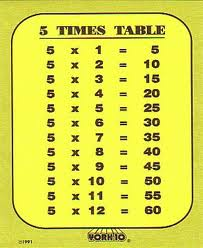 The Common Core Curriculum states that ”[b]y the end of Grade 3, know from memory all products of two one-digit numbers. The question is, how many students actually know them? One adult scientist has noted: ”I’m 49 years old, have a PhD in physics, and teach math and physics for a living. When I need to know 4×9, I do it as 18+18. I don’t have it memorized that it’s 36. I’ve done it this way since I was a kid, and I do it very quickly. Why is this a problem?” Others have suggested that with the advent of calculators, there is no longer any need to know the times facts. Nevertheless, it still is important to teach students the concept of multiplication, and so you might as well teach the times tables while you’re at it! Here are eight creative ways you can do this based on Howard Gardner’s theory of multiple intelligences:
The Common Core Curriculum states that ”[b]y the end of Grade 3, know from memory all products of two one-digit numbers. The question is, how many students actually know them? One adult scientist has noted: ”I’m 49 years old, have a PhD in physics, and teach math and physics for a living. When I need to know 4×9, I do it as 18+18. I don’t have it memorized that it’s 36. I’ve done it this way since I was a kid, and I do it very quickly. Why is this a problem?” Others have suggested that with the advent of calculators, there is no longer any need to know the times facts. Nevertheless, it still is important to teach students the concept of multiplication, and so you might as well teach the times tables while you’re at it! Here are eight creative ways you can do this based on Howard Gardner’s theory of multiple intelligences:
Word Smart: tell a story about a family with magical powers; one child can double anything he touches, another can triple them, another can quadruple them . . . and so on up to 9-fold. Then, send the family members on various adventures (e.g. the time that the tripler touched four golden hens, the time that the ”eight- times-er” picked up seven pebbles from a stream etc.). You can draw these scenarios or act them out as a role play in the classroom.
Number Smart: brainstorm all the different ways you could express a times fact (e.g. 3 x 4 could be 4+4+4 or 3+3+3+3 or 4 x 1, or 3 x 2 or 2 x 3, etc.).
Picture Smart: create a circle with the numbers from 0 to 9 around the inner circumference (like a clock) – then do, let’s say, the threes by starting at 0 and then connecting up with a straight line every third number; see what kind of shape you end up with after reaching 30 – then do the same thing with the other multiples (hint: you might get a little dizzy doing the ”fives” up to 500!).
Body Smart: form a conga line as a class and begin marching and counting from 1 to 82; every time you reach a multiple of two or three or (up to nine), jump up on that particular number – a great way for kids to learn their sevens and eights as thoroughly as they know their twos and fives.
Music Smart: ask the class to count out loud from 1 to 36 – anytime they reach a multiple of three (or four, five etc.), have them clap on that number – you can make this more challenging by splitting the class into two groups and having one group clap on every third number and the other group clapping on every fourth number etc.
Nature Smart: go outside where there are flowers or bushes with blooms and ask the class to find examples of 3 x 4 (e.g. three flowers with four petals each), 3 x 5, 3 x 6 etc.
People Smart: do the Picture Smart activity (circle from 0 to 9), only do it as a circle of kids, each with a number attached to their clothes (from 0 to 9). Then take a ball of yarn and starting with 0, pass the ball along from person to person and if the student happens to represent a multiple of three (or four, five, six, etc.) then have them hold onto a section of the yarn, so the group can make polygons for each multiple.
Self Smart: give students Cuisenaire Rods or other blocks with values from 1 to 10 – then have them explore different ways of combining the blocks to make different times facts (e.g. through self-exploration, they can see that five blocks of ”sixes” are equivalent to six blocks of ”fives” etc.).
There are a lot of other ideas and activities out there for exploring multiplication and the times table (I once wrote a guitar tune called ”The Times Table Blues” where we sang the times fact to a blues refrain). The important thing is to keep these activities fun!
For more ideas using the 8 Kinds of Smart in teaching practically anything, see my book Multiple Intelligences in the Classroom (ASCD).
This article was brought to you by Thomas Armstrong, Ph.D. and www.institute4learning.com
Follow me on Twitter: @Dr_Armstrong



















